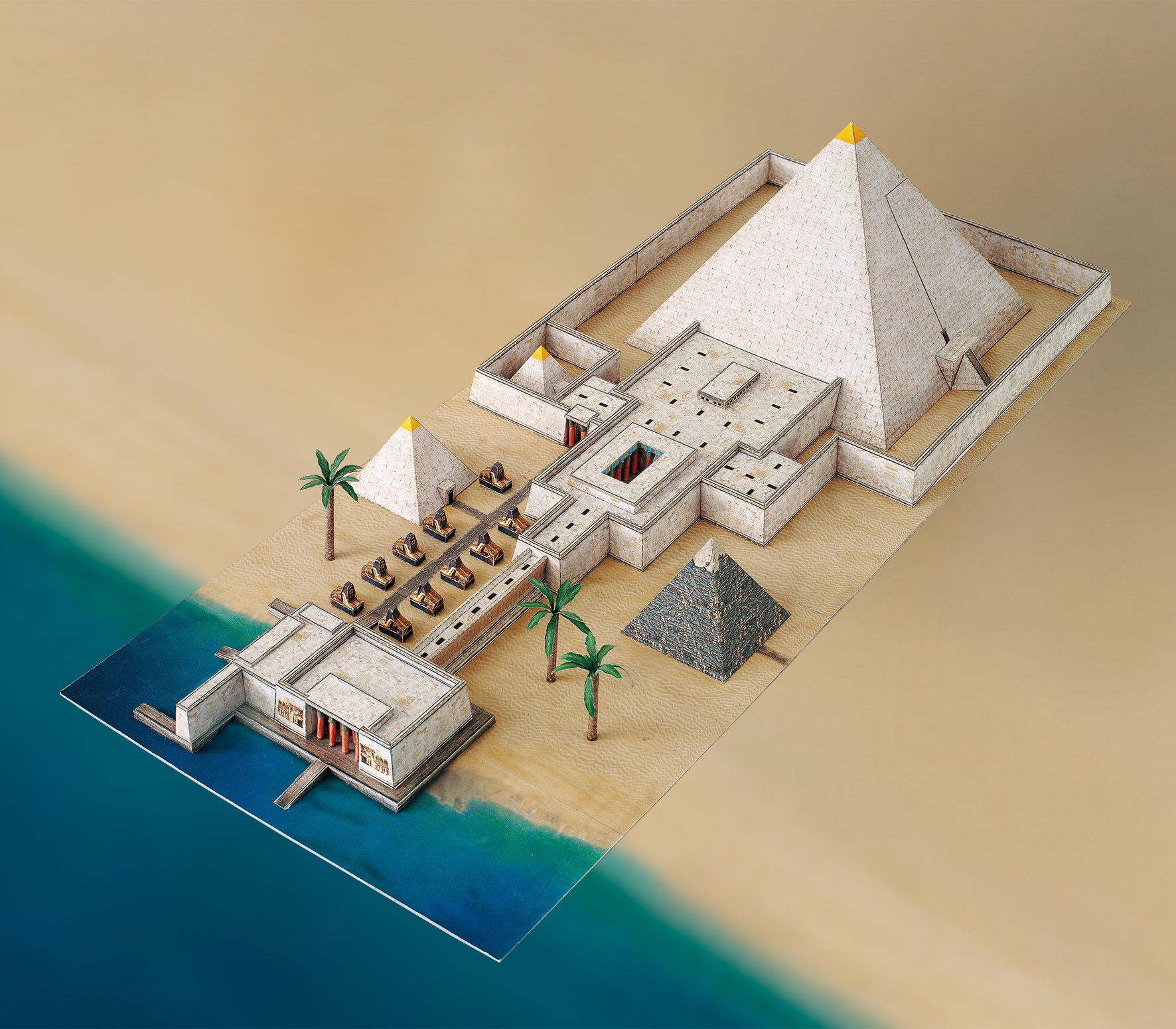Egyptian Pyramid Plant - Schreiber Bogen
Product number:
2852
The model shows the typical structure of an Egyptian pyramid complex from the time of the Old Kingdom (2700 - 2170 BC):
The complex includes:
- Valley temple
- Processional way
- Worship temple
- Main pyramid, cult pyramid and secondary pyramids
An ancient Egyptian pyramid complex as a construction sheet from PGI - you can hardly teach this subject to your pupils in a more descriptive and motivating way.
You will also receive free building instructions, descriptions and worksheets for use in class that are coordinated with the model.
Scale 1:400
8.5 sheets of A4
Sturdy, coloured paper
70 cm long, 30 cm wide, 13 cm high
| Aspiration scale: | Medium |
|---|---|
| Time Line: | 2,5 Hours |
Product information "Egyptian Pyramid Plant - Schreiber Bogen"
Pyramid with valley temple
The pyramid is a building form with a square base known from various ancient cultures. A typical Egyptian pyramid complex consisted of various building elements. The pyramid itself was the centre of a sacred complex. Inside they had corridors and burial chambers. It was connected to the Valley Temple on the banks of the Nile by a processional passage. The Valley Temple consisted of an entrance hall, a portico and a room with statues, shrines and storage chambers. In this temple, the deceased king was worshipped as a deity. The king's relatives were buried in the small side pyramids. The tombs of royal officials were also located nearby.
Limestone, granite and sandstone were used to build the pyramids. To this day, it is not certain how the workers transported the building material to the growing pyramid. Presumably, they built a ramp around the pyramid on which the stones were hauled up. The number of Egyptian pyramids is not known exactly. The largest and best known is the Pyramid of Khufu at Giza with a floor area of 52,900 m² and an original height of 146.60 metres. According to tradition, 70,000-100,000 workers were involved in the construction of the Pyramid of Khufu. Today's research rather assumes 8 000 workers. Little is known about the legal status of the workers. Scientists assume that the majority of the workers were not slaves. For example, labourers from Lower Egypt are said to have been used for pyramid construction. In some cases, a labour distribution office took over the provision and supply of workers.
There are many theories in ancient research about the construction of pyramid-shaped places of worship. The most probable is that pyramids stood for the Egyptians' belief in creation. The pyramid was supposed to represent the primordial mound from which, according to Egyptian mythology, all creation arose. Another theory is that the Egyptians considered the opening bundle of sun rays, which became visible when light fell through a loose cloud cover, to be a divine sign and built them in the form of pyramids. It is also possible that pyramids symbolised stairways to heaven. Deceased kings could use them to reach the sun god Re. There is also the theory that step pyramids represented the structure of society in ancient Egypt. However, pyramids are also often referred to simply as architectural advancements. Originally, so-called mastabas, flat square structures, served as burial chambers. The first stepped pyramid was built under King Djoser. This later developed into the pyramids as we know them today.
This model shows a typical Egyptian pyramid complex with a valley temple, processional aisle, worship temple, main pyramid and secondary pyramids. A segment of the main pyramid can be removed and allows a view of the corridors inside.
The pyramid is a building form with a square base known from various ancient cultures. A typical Egyptian pyramid complex consisted of various building elements. The pyramid itself was the centre of a sacred complex. Inside they had corridors and burial chambers. It was connected to the Valley Temple on the banks of the Nile by a processional passage. The Valley Temple consisted of an entrance hall, a portico and a room with statues, shrines and storage chambers. In this temple, the deceased king was worshipped as a deity. The king's relatives were buried in the small side pyramids. The tombs of royal officials were also located nearby.
Limestone, granite and sandstone were used to build the pyramids. To this day, it is not certain how the workers transported the building material to the growing pyramid. Presumably, they built a ramp around the pyramid on which the stones were hauled up. The number of Egyptian pyramids is not known exactly. The largest and best known is the Pyramid of Khufu at Giza with a floor area of 52,900 m² and an original height of 146.60 metres. According to tradition, 70,000-100,000 workers were involved in the construction of the Pyramid of Khufu. Today's research rather assumes 8 000 workers. Little is known about the legal status of the workers. Scientists assume that the majority of the workers were not slaves. For example, labourers from Lower Egypt are said to have been used for pyramid construction. In some cases, a labour distribution office took over the provision and supply of workers.
There are many theories in ancient research about the construction of pyramid-shaped places of worship. The most probable is that pyramids stood for the Egyptians' belief in creation. The pyramid was supposed to represent the primordial mound from which, according to Egyptian mythology, all creation arose. Another theory is that the Egyptians considered the opening bundle of sun rays, which became visible when light fell through a loose cloud cover, to be a divine sign and built them in the form of pyramids. It is also possible that pyramids symbolised stairways to heaven. Deceased kings could use them to reach the sun god Re. There is also the theory that step pyramids represented the structure of society in ancient Egypt. However, pyramids are also often referred to simply as architectural advancements. Originally, so-called mastabas, flat square structures, served as burial chambers. The first stepped pyramid was built under King Djoser. This later developed into the pyramids as we know them today.
This model shows a typical Egyptian pyramid complex with a valley temple, processional aisle, worship temple, main pyramid and secondary pyramids. A segment of the main pyramid can be removed and allows a view of the corridors inside.
What else you need for assembly
> scissors or a cutter, e.g. craft knife
> a good all-purpose glue, e.g. craft glue
> a blunt knife for folding
> a ruler

